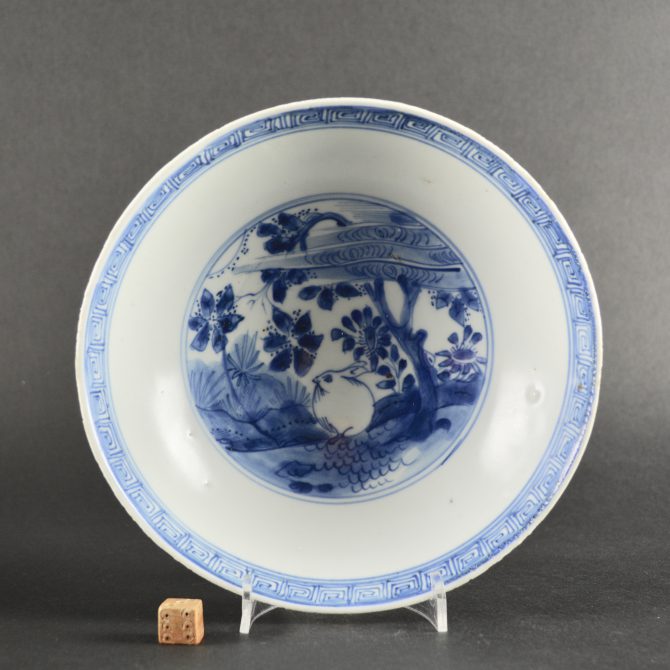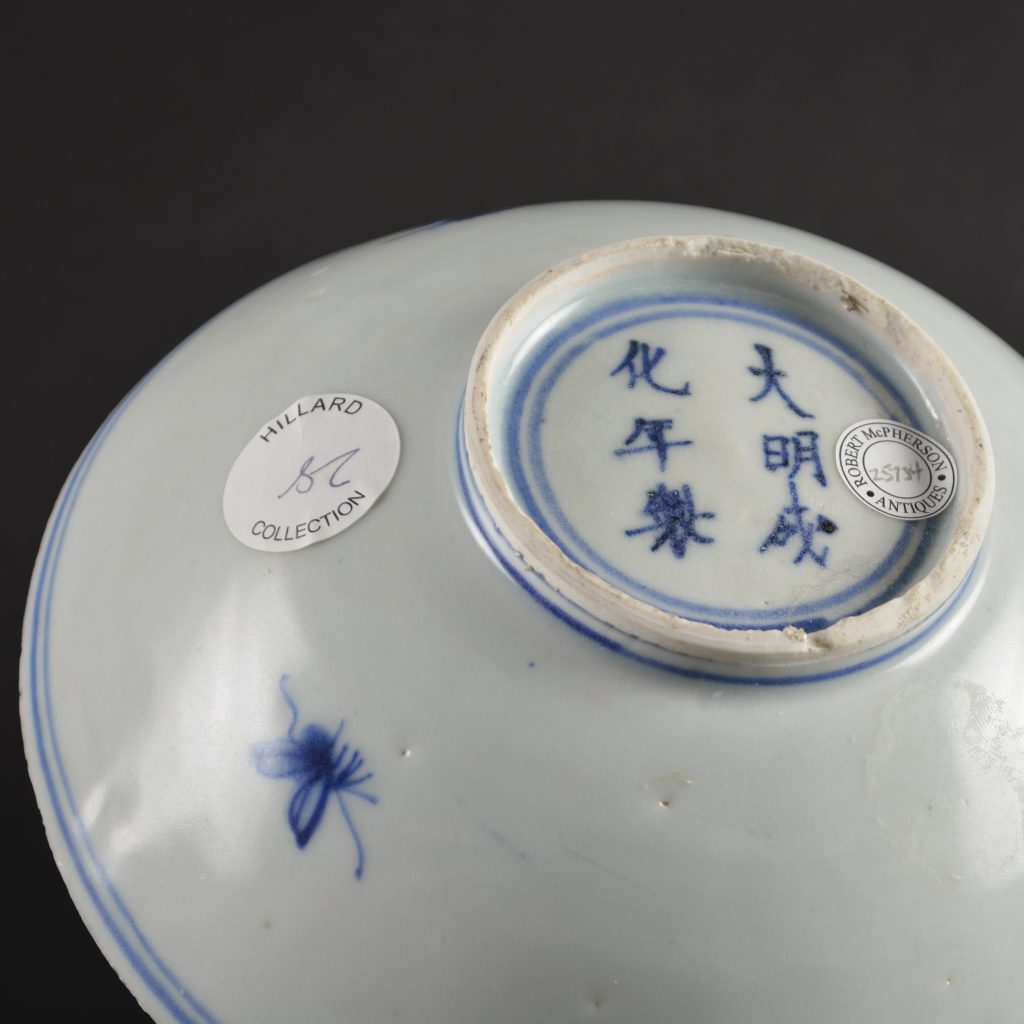
A Transitional Porcelain Bowl From The Hatcher Cargo
A Transitional Blue and White Porcelain Bowl. Late Ming Dynasty, Chongzhen Period c.1643. This well painted bowl in rich blue tones depicts a hare, or maybe a rabbit, as the ears appear a little short for that of a hare. It perhaps depicts the `moon hare`, Yuetu, who lives on the moon with the Goddess of the Moon or it might be a rabbit with a very different story associated with it – See ‘Information’ below. The moon is depicted on the top left-hand side of the central design. The base has an apocryphal Chenghua mark (Ming dynasty 1465-1487).
SOLD
- Condition
- In excellent condition, the glaze is bright and reflective. It is only really possible to tell that this is a shipwreck piece by rubbing your fingers against the surface, there is an almost imperceptible roughness. Minor fritting, some footrim chip that are likely to be firing faults.
- Size
- Diameter 17.5 cm (7 inches)
- Provenance
- Fine And Important Late Ming And Transitional Porcelain, Recently Recovered from an Asian Vessel in the South China Sea. Property of Captain Michael Hatcher. Christie`s Amsterdam 14th March 1984. No label. From the collection of Chinese Porcelain belonging to James Hillard, Professor of Psychiatry at Central Michigan University College of Medicine. Hillard Collection label.
- Stock number
- 25734
- References
- Blue and White Transitional Bowls of this shape and design from the `Hatcher Junk` of c.1643 are illustrated in : Fine And Important Late Ming And Transitional Porcelain, Recently Recovered from an Asian Vessel in the South China Sea. Property of Captain Michael Hatcher. Christie`s Amsterdam 14th March 1984. Page 40, lot 203. More Hatcher bowls of this design were sold, see : Fine and Important Late Ming and Transitional Porcelain, The second and Final Part of the Hatcher Collection, Recently Recovered from an Asian Vessel in the South China Sea. Christie's Amsterdam, 1th and 13th of June 1984. Page 85, illustrated on page 86, lots 986 and 987. For a bowl of this design from the Hatcher Cargo auction of March 1984 see : An Era of Inspiration, 17th Century Chinese Porcelain from the Collection of Julia and John Curtis. Christie's New York, 16th of March 2015, lot 3514.
Information
Apocryphal Marks
Apocryphal marks are frequently encountered on Chinese porcelain particularly on Kangxi Blue and White Porcelain, the mark of the Ming Emperor Chenghua who reigned from 1465 to 1487 being by far the most common, other Ming marks include Jiajing (1522-1566) and less frequently Wanli (1573-1620). These marks were not added to the piece to deceive, but more as a sign of reverence to earlier potters of the Ming dynasty (1368-1644). Occasionally they are used on pieces copying Ming Porcelain, these objects were probably made for collectors who could not afford the Ming original. Tianqi is an early period for such an apocryphal mark.
The Hare and the Moon - Yuetu
There are several early cultures that associate a hare with the moon, this is because it is possible to interpret part of the surface of the moon as a hare. It is said the Chinese mythological white-hare grinds the elixir of immortality with a pestle and mortar on the Moon. In some Chinese images a hare can be seen grinding herbs and acacia twigs in a mortar and pestle to create this magical elixir. According to Taoist tradition the `moon hare`, Yuetu, lives on the moon with the Goddess of the Moon, Chang-E, who stole the elixir from the archer Yi. As well as being associated with longevity the hare is connected with fertility as it is supposed to conceive while gazing at the moon.
A Buddhist story about a rabbit and the moon provides a very different explanation. The Buddha arrived in a forest, exhausted and hungry after many days traveling. All the animals came to him bringing foods they usually gathered for themselves. The rabbit intended to bring fresh green grass and leaves but when he found them he ate them himself. The rabbit was consumed by guilt and confessed what he had done. The rabbit offered himself as a replacement meal, the Buddha was so touched by this dramatic gesture that he bestowed upon the rabbit the gift of eternal life on the moon. Rabbits are therefore associated with long life.

The Hatcher Cargo :
The Hatcher Cargo was the first porcelain cargo from a shipwreck to come on to the market. It was sold in several auctions in Christie`s Amsterdam in 1984 and 1985. It remains one of the most important cargoes of shipwreck ceramics ever recovered, despite the lack of historical evidence recorded by the salvage team. Two porcelain covers dated 1643 helped date the wreck but this needed corroborating to give a firm date of the wreck and it`s cargo.
The dating of the porcelain from the Hatcher Cargo is based on several elements. Firstly, the ceramics recovered form a coherent group, in other words they appear to all have been made at the same time. Secondly comparative dating was used to corroborate the date of the porcelain. For example, blue and white porcelain dishes decorated with a coiled serpent recovered from the Hatcher Cargo match an important dish from the fall of the Ming dynasty, formerly in the Percival David Foundation, now at the British Museum London, this dish can be dated to 1644 - 1645.
Other comparative dating is also consistent with the presumed date of the porcelain. However, the most important dating reference remains the two covers recovered from the wreck datable by inscription to the spring of 1643. Although the Ming dynasty officially ended in 1644 the transition from the Ming to the beginning of the Qing was messy and protracted. The porcelain made during this period of civil war and chaos is referred to as `Transitional Porcelain`. It covers the period from the last Ming Emperors until the early years of the Kangxi period, which is normally given a date of about 1620 to 1670 . The Hatcher Cargo is a vital dating tool for this previously poorly understood period of Chinese porcelain production.









